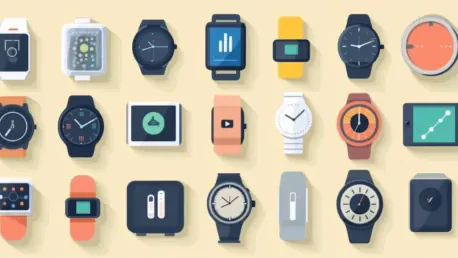The wearable technology market is on a trajectory of rapid and impressive growth, driven by rising health and fitness trends. With an expected market size to reach USD 198.8 billion by 2032, the sector is witnessing a surge in consumer demand for health monitoring, fitness tracking, and hands-free communication devices. This article delves into the factors contributing to this growth, key players in the industry, segment analysis, regional development, and recent notable developments.
Factors Driving Market Growth
Rising Health and Fitness Trends
The post-pandemic era has seen a heightened awareness and concern for health and wellness, significantly boosting the demand for wearable technology. Consumers are increasingly seeking devices that can monitor their health metrics, such as heart rate, calorie intake, and hydration levels. This trend is particularly evident among athletes and fitness enthusiasts who rely on smartwatches and fitness trackers to enhance their performance and maintain their health. Moreover, these devices offer features such as sleep monitoring and stress management, which cater to the holistic well-being of users and further broaden their appeal.
The demand for wearable technology is not only confined to individual consumers. Corporate wellness programs are increasingly incorporating these devices to promote employee health and productivity. Employers are recognizing the value of wearable technology in reducing healthcare costs and improving workplace well-being. This integration of wearables into the corporate sector has opened up new avenues for market growth and underscores the multifaceted utility of these devices.
Technological Advancements
Technological giants like Apple Inc., Samsung Electronics, and Fitbit Inc. (part of Google LLC) are at the forefront of this market, offering innovative products that cater to the evolving needs of consumers. The introduction of advanced features in devices such as the Apple Watch Series 9 and Galaxy Watch 6 has set new benchmarks in the industry. These advancements are not only enhancing user experience but also expanding the scope of wearable technology applications. For instance, the integration of electrocardiograms (ECG) and blood oxygen level monitoring in new smartwatch models provides users with critical health insights that were previously accessible only through clinical devices.
In addition to hardware improvements, there have been significant strides in software and data analytics capabilities. Machine learning algorithms and artificial intelligence are being integrated into wearable devices to provide personalized health recommendations and predictive insights. These technologies enable wearables to offer more precise and actionable data, thereby increasing their value proposition. As wearables continue to evolve, their applications are expected to extend beyond health and fitness to areas such as assisted living and workplace safety, highlighting the transformative potential of technological advancements in this sector.
Key Players in the Industry
Leading Companies and Their Flagship Products
Apple Inc., Samsung Electronics, Fitbit Inc., and Garmin Ltd. are some of the key players spearheading the wearable technology market. Each of these companies offers flagship products that are crucial in driving the market. For instance, the Apple Watch Series 9 and Fitbit Charge 5 have garnered significant consumer interest due to their advanced health monitoring features and user-friendly interfaces. Apple’s continuous innovation in its HealthKit platform also enhances the Apple Watch’s ecosystem, making it a favorite among consumers for seamless health tracking. Similarly, Fitbit’s acquisition by Google has allowed for integration with Google Health services, further enriching its feature set.
Garmin, known for its strong presence in the fitness tracker segment, has consistently rolled out products that cater to professional athletes and outdoor enthusiasts. Its devices offer specialized metrics like VO2 max and advanced running dynamics, differentiating them from more general-purpose wearables. Samsung’s Galaxy Watch series has equally made strides, especially with its comprehensive fitness and health-tracking capabilities. The partnership with the National Sleep Foundation indicates Samsung’s commitment to addressing specific health issues, such as sleep disorders, which are likely to attract a wider audience concerned about their sleep quality.
Other Notable Companies
Apart from the leading giants, other notable companies such as Xiaomi Corporation, Huawei Technologies, Fossil Group, Polar Electro Oy, Withings S.A., and Amazfit are also making significant contributions to the market. These companies have developed a range of products, from smartwatches to fitness trackers and body scales, catering to diverse consumer needs and preferences. Xiaomi, for instance, has gained a substantial market share by offering affordable yet feature-rich fitness bands. The Mi Band series is particularly popular in emerging markets, where cost-effective solutions are in high demand.
Huawei Technologies has focused on integrating advanced sensor technology into its wearables, exemplified by the HUAWEI TruSense system. This focus on sensor technology not only enhances the accuracy of health metrics but also positions Huawei as a key player in the premium wearable segment. Fossil Group, on the other hand, has leveraged its expertise in traditional watchmaking to produce aesthetically pleasing smartwatches that appeal to fashion-conscious consumers. The diverse strategies and offerings of these companies contribute to the overall dynamism and competitiveness of the wearable technology market.
Segment Analysis
Product Segmentation
The wearable technology market is segmented based on product and application. The wrist-wear product segment, which includes smartwatches and fitness trackers, dominated the market in 2023, accounting for over 49.39% of total revenue. This dominance is largely due to the widespread adoption of these devices by individuals keen on monitoring their fitness metrics. The ease of use, accessibility, and continuous innovation in wrist-wear products have made them a staple in the consumer electronics market. Smartwatches, in particular, have evolved beyond simple notification devices to become comprehensive health and fitness companions.
In addition to wrist-wear, other product categories such as hearables, bodywear, and eyewear are also gaining traction. Hearables, which include wireless earbuds and hearing aids with advanced features like noise cancellation and biometric monitoring, have shown significant potential. Bodywear, such as smart clothing and chest straps, offers specialized functionalities for professional athletes and patients requiring continuous monitoring. Eyewear, particularly smart glasses, is emerging as a promising segment, with applications in augmented reality and workplace productivity. The diversification of product offerings within the wearable technology market highlights the sector’s expansive growth potential.
Application Segmentation
The consumer electronics application segment led the market in 2023, garnering over 48.95% of the total revenue. This leadership is indicative of the broad consumer acceptance and integration of wearable devices, ranging from fitness bands to AR/VR headsets. Manufacturers such as Garmin, Omron, and Apple focus on developing devices that provide a mix of clinical and non-clinical data, further driving market growth. The versatility of wearable devices in consumer electronics has enabled their adoption for various purposes, including entertainment, navigation, and communication.
The healthcare segment showed promise of registering the second-fastest growth rate during the forecast period. Wearable devices play an integral role in the pharmaceutical industry, offering functionalities such as telehealth solutions and mobile applications for virtual patient monitoring. This surge in telehealth and remote patient monitoring is anticipated to further drive the demand for wearable technology in healthcare. Additionally, wearables are becoming crucial tools for chronic disease management, enabling patients to monitor conditions like diabetes and hypertension in real-time. The integration of wearable technology in clinical trials and personalized medicine further underscores its transformative impact on healthcare.
Regional Development
North America: Market Leader
North America led the global wearable technology market in 2023, securing 34.80% of the total revenue. The region’s high adoption rates of advanced technology, robust healthcare infrastructure, and ongoing new product launches contribute to its leading position. Additionally, the pressing demand for preventive healthcare and chronic disease management, especially in the U.S., heightens the need for wearable devices. The presence of prominent market players and a tech-savvy consumer base further augment North America’s dominance in the wearable technology sector.
Government initiatives and support for digital health solutions also play a pivotal role in the market’s growth in North America. Policies promoting the use of wearable technology in healthcare and wellness programs are driving increased adoption among both consumers and healthcare providers. The integration of wearables with healthcare management systems and electronic health records (EHR) is becoming more prevalent, enabling seamless data exchange and improved patient outcomes. The focus on research and development in wearable technology is another critical factor, with numerous partnerships between tech companies and academic institutions fostering innovation.
Asia Pacific: Fastest Growing Region
Conversely, the Asia Pacific region presents the fastest growth opportunities from 2024 to 2032, with China spearheading the charge. The rising demand for wearables in the region, coupled with falling handset prices, is expanding access to these devices. The increasing focus on affordable and easily accessible wearable technology in China promises to significantly bolster market growth. The region’s large population, growing middle class, and increasing disposable incomes are major contributing factors to the market’s expansion. Additionally, government initiatives aimed at promoting digital health and wellness are further fueling the adoption of wearable technology.
India, Japan, and South Korea are other notable markets within the Asia Pacific region that are experiencing rapid growth. India’s burgeoning tech sector and increasing internet penetration are creating a conducive environment for the proliferation of wearables. Japan’s advanced healthcare system and aging population make it a prime market for health-centric wearable devices. South Korea, known for its technological prowess, is witnessing significant adoption of wearables for both fitness and healthcare purposes. The Asia Pacific region’s dynamic growth trajectory underscores its potential to become a key player in the global wearable technology market.
Recent Notable Developments
Technological Innovations
Recent developments within the market corroborate its dynamic and evolving nature. For instance, in August 2024, Huawei introduced the HUAWEI TruSense system, marking a significant advancement in fitness and health sensor technology. This innovation is likely to enhance Huawei’s future wearable offerings, setting new standards in the industry. The TruSense system incorporates advanced biometric sensors that provide high accuracy and real-time data analytics. This system is expected to revolutionize how consumers interact with their health data, offering more personalized and actionable insights.
Additionally, other companies are making notable advancements in sensor technology, battery life, and user interface design. Innovations such as flexible displays, energy-efficient processors, and enhanced connectivity features are driving the next generation of wearable devices. These technological breakthroughs not only improve device performance but also expand the range of applications for wearables. From smart fabrics that monitor biometric data to augmented reality glasses that enhance workplace productivity, the continuous innovation in wearable technology is setting the stage for its future growth.
Strategic Partnerships
The wearable technology market is experiencing significant and rapid expansion, largely driven by growing health and fitness trends. Forecasts predict the market will reach a substantial USD 198.8 billion by 2032. This increasing consumer demand encompasses various devices, such as health monitoring gadgets, fitness trackers, and hands-free communication tools.
This article explores several factors contributing to this market growth including lifestyle changes leading to higher health awareness, technological advancements enhancing device functionality, and the integration of AI and IoT in wearables. Key industry players, such as Fitbit, Apple, and Garmin, are at the forefront, continually innovating and capturing market share by offering advanced features.
Segment analysis highlights the predominance of smartwatches and fitness bands, while regional development shows North America and Asia-Pacific leading the charge due to higher disposable incomes and tech adoption rates. The article also touches on recent notable advancements, such as the integration of new health monitoring capabilities, which propel the market forward, showing promise and potential for even more growth in the wearable technology sector.









